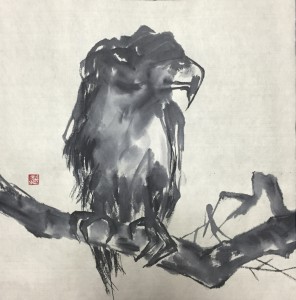書の基本は臨書です。つまり、空海や王羲之のような名筆をお手本にして練習することで基本を身に付けるのです。そういったお手本はいくらでもあって、半紙で練習しても練習しても終わりはありません。そうしているうちに、自分のスタイルを見つけて作品が書けるようになるのです。
墨絵も、同じような方法で基本を学ぶことはありますが、私はそういうやり方をしたことがありませんでした。ところが、最近になって模写をしてみたら、墨絵でも書の臨書同様、色々な発見があることに気付きました。画像は、私の大先生である内山雨海先生の「サルクイワシ」を模写したものです。模写をしてみると、先生がどこから描き始めたのか、どういう意図を持っていたのかがよくわかります。同時に、自分のタッチや個性がよくわかるのです。これは面白い発見でした。
こういう勉強の仕方も必要だな。たまには私の生徒さんたちにも臨画(模写)をしてもらってもよいかもしれません。偉大な先人の作品には身に付けたい技術が詰まっています。
The Basic of calligraphy is Rinsho, which is to say that we learn the basics from copying the examples of great masters such as Kukai and Wang Xizhi. There are so many examples and we do not end no mutter how we practice on the rice paper. In the meantime, we can find our own style and create art works.
There is the same way with sumi-e. I had never studied with this way, but a little while ago, I copied a work of Ukai Uchiyama, the great master of sumi-e, then I found many useful things from it. The photo is the one I copied ‘Sarukuiwashi’ of Ukai Uchiyama. While I copying, I noticed from where he had started to draw and how he had drawn it. At the same time, I found my individuality. It was interesting.
I discoverd that this way is also needed to progress. I think it is necessary for my students to do it sometimes. There are a lot of useful techniques in the works of great artists.
